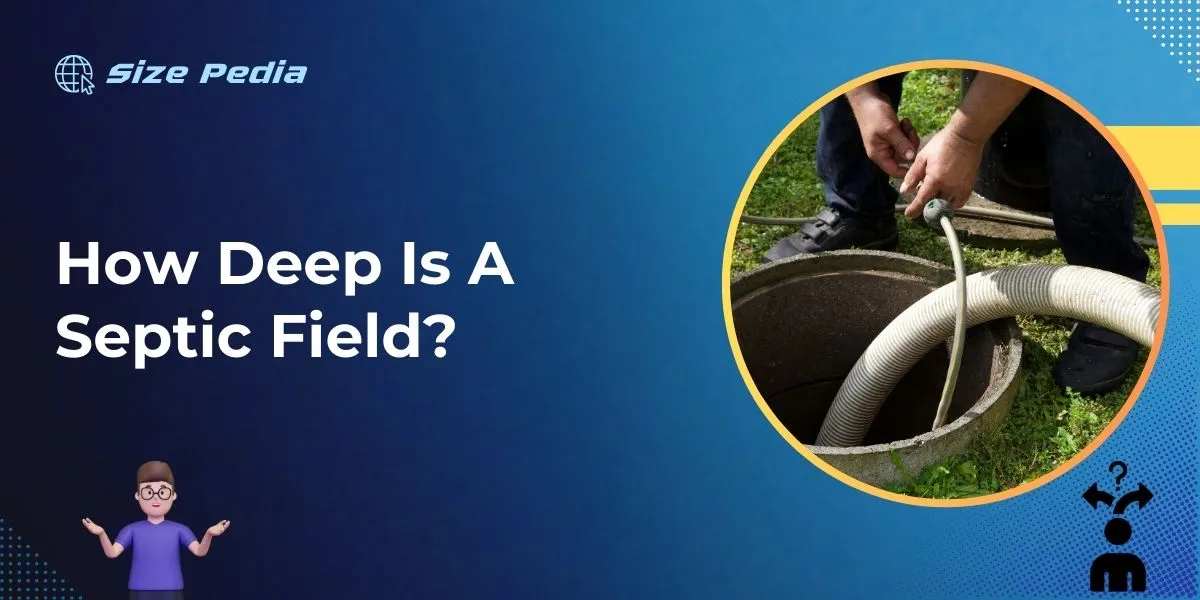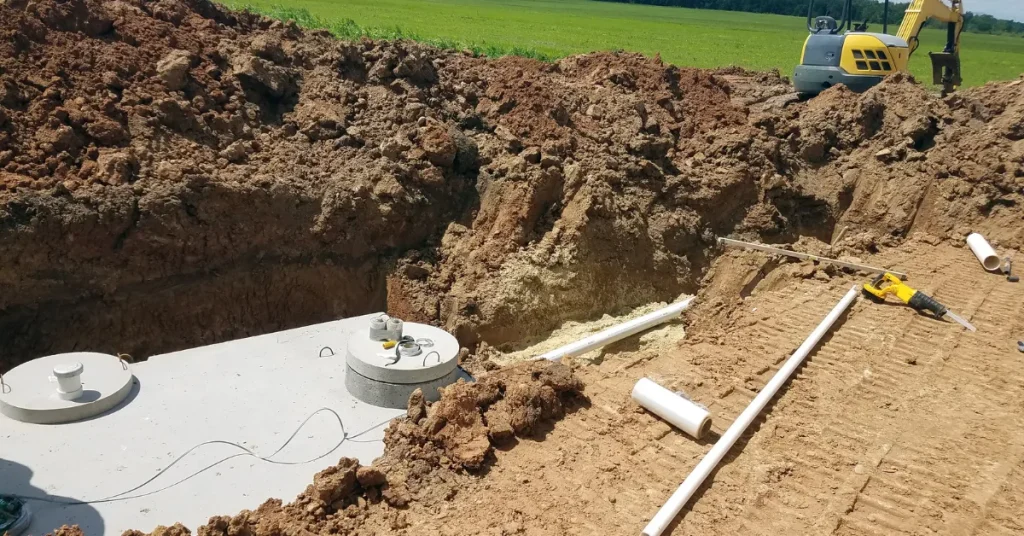A septic field, also known as a drain field, is typically 1 to 3 feet deep. A septic field’s depth can vary based on soil conditions and local regulations.
A properly functioning septic system is crucial for residential waste management, particularly in areas lacking centralized sewer systems. Septic fields serve the critical role of filtering and purifying effluent from the septic tank before it returns to the groundwater.
Understanding the intricacies of your septic system, including the depth of its components, can aid in efficient maintenance and prevent costly repairs.
Homeowners and builders should consult local health department codes and guidelines to determine the specific requirements for their septic field installations.
Ensuring the correct depth is essential for the longevity of the septic system and for protecting the environment from contamination.

The Significance Of Septic Field Depth
A septic field’s depth is crucial for its function and safety. Proper depth ensures that waste is effectively treated and that contaminants do not reach surface water or groundwater.
A well-designed depth protects the environment and public health. This section of the blog will dive into why the septic field depth matters.
Balance Between Efficiency And Safety
Getting the depth right for a septic field is a balancing act. Too shallow, and you risk contamination and system failure. Too deep, and the system might not treat waste effectively.
The correct depth allows for microorganisms in the soil to process the effluent, turning it into safe substances. These microorganisms need oxygen, which is found closer to the surface.
But, the system must also be deep enough to avoid human and animal contact. Let’s look at the factors that influence this balance:
- Soil type: Sandy soils drain fast but may need deeper fields for adequate treatment. Clay soils drain slowly and are often shallower.
- Water table: To prevent contamination, the field should be above the high water table.
- Effluent quality: Higher quality pre-treatment may allow for shallower fields.
Knowing local conditions helps professionals determine the ideal depth.
Regulatory Requirements For Septic Depth
Regulations play a role in septic field designs. Policies ensure systems work well and prevent health risks. They may vary by location but have common elements. Here are some guidelines that might apply:
| Septic System Component | Typical Depth Requirement |
| Trench Bottom | 18-30 inches below ground surface |
| Pipes | At least 6-12 inches of soil cover |
| Drain Field | 12 inches above groundwater table |
Local health departments can provide specific requirements. It is vital to comply to prevent fines and ensure safety. Always consult a professional for advice tailored to your area.
Factors Determining Septic Field Depth

Understanding the factors that determine the depth of a septic field is key to successful system installation and function. The depth at which a septic field is installed impacts its efficiency, longevity, and safety to the environment.
Several elements must be considered to find the optimal depth necessary for a septic field to operate effectively. Let’s explore these critical factors.
Soil Type And Percolation Rate
The type of soil where a septic field is to be installed plays a significant role in determining depth. Soil compositions vary greatly, from sandy to clay-heavy soils, and each type has unique percolation rates, which is the speed at which water filters through the soil.
- Sandy soils allow for quick water movement; thus, a deeper septic field may not be necessary.
- Clay soils, slow to drain, often require a shallower field to ensure proper waste treatment.
A percolation test, usually conducted by a professional, is essential to determine this rate and guide the depth placement of the septic field.
Water Table And Environmental Considerations
The water table’s height affects septic field depth. A high water table can lead to groundwater contamination if the septic field is not placed at a suitable depth.
Environmental factors such as nearby water bodies also influence the necessary depth. Mandatory minimum distances from these features ensure that the septic field does not harm the ecosystem. Local regulations may define these distances and depths.
It’s important to consider factors like potential flooding and seasonal water level changes. This ensures that the septic system remains functional throughout different environmental conditions.
Standard Depths Explained
Welcome to the discussion on Standard Depths Explained for a septic field. A septic field, crucial for treating and dispersing wastewater, must be properly installed.
The depth at which it is placed is vital. It impacts effectiveness and safety. Let’s break down the standard depths at which septic fields are commonly installed.
Common Ranges For Septic Field Installation
Septic fields have typical depth ranges that are essential for optimal function. Here are some key depths:
- Drainage pipes: These lie about 12 to 18 inches below the ground surface.
- Leach field: It sits 18 to 30 inches underground, allowing for effective wastewater treatment.
- Gravel layer: Commonly, this layer is up to 12 inches thick, placed just under the pipes for filtration.
Soil cover above the leach field also matters. A layer of 6 to 12 inches is typical for protection.
Variations By Climate And Geography
The depth of a septic field can vary based on location. Key factors include climate and soil type. Please see the table below:
| Climate/Geography | Depth Adjustment |
| Cold weather regions | Deeper fields to prevent freezing |
| High water table areas | Shallower fields for better drainage |
| Sandy soils | Depth adjusted for quicker filtration |
| Clay soils | Deeper fields to aid slow absorption |
In warmer climates, fields are often closer to the surface. It allows for evaporation and transpiration. In colder zones, fields are buried deeper, combating the risk of freezing.
Geographical features also dictate depth. It must ensure optimal functioning and environmental safety.
Digging Deeper: Unusual Circumstances
Digging Deeper: Unusual Circumstances can affect how deep a septic field should be. Conditions like extreme weather or new technology change common practices. Let’s explore these factors.
Extreme Weather Conditions And Depth Adjustments
Extreme weather impacts septic field depth. Heavy rain, flooding, and drought change soil conditions. Septic systems need protection from these events. Here’s what to consider:
- Flooding: High water tables require deeper septic fields to prevent contamination.
- Drought: Dry conditions might need shallower fields for adequate waste filtering.
- Cold Climates: Frost lines can dictate how deep to place the septic field to avoid freezing.
Technological Advances In Septic System Design
New technology allows unique solutions for septic system depth. These innovations include:
| Technology | Benefit | Depth Impact |
| Pressure Dosing | Distributes waste evenly | May allow shallower fields |
| Advanced Treatment Systems | Purifies waste better | Possible reduced depth requirements |
| Drip Irrigation | Uses small dose intervals | Custom depths to match soil conditions |
Such advancements can lead to safer, more efficient septic systems, saving space and resources.
Maintaining Your Septic Field

A healthy septic system is vital for any property. Proper care ensures this underground workhorse keeps the environment clean. Let’s explore the depths of septic field care for sustained efficiency.
Regular Inspections And Depth Monitoring
Consistent check-ups safeguard your septic system. Specialists should inspect it yearly. Homeowners can also learn basic inspections. Spot minor issues before they escalate. Checking sludge levels is critical for preventing backups. Let’s unpack this crucial task.
- Schedule professional inspections annually.
- Understand your system’s layout and components.
- Monitor sludge and scum levels regularly.
- Keep records of inspections and maintenance.
| Inspection Item | Action | Frequency |
| Sludge Depth | Measure | Annually |
| Scum Layer | Check | Annually |
| Pipes and Drains | Examine | Every 3-5 Years |
Impact Of Septic Depth On System Longevity
Correct septic field depth prolongs your system’s life. It prevents freezing and fosters efficient waste breakdown. A field too shallow risks contamination and system failure. A suitable depth varies by location and soil type.
- Avoid shallow installations in colder regions.
- Ensure installation meets local regulations.
- Seek expert advice for your area’s best practices.
Remember, the ideal depth maximizes system performance and lifespan. Treat your septic field well, and it will return the favor!
FAQs About How Deep Is A Septic Field
What Is The Standard Depth Of Septic Fields?
The standard depth of a septic field, or drainfield, typically ranges from 18 to 30 inches below the surface. Distances can vary based on local regulations and soil conditions.
How Deep Should Septic Leach Lines Be?
Septic leach lines are generally installed at a depth of 18 to 36 inches. The exact depth may depend on soil percolation rates and local building codes.
Can A Septic Field Be Too Deep?
Yes, a septic field can be too deep. Overly deep installation can lead to reduced oxygen exchange, disrupting the treatment process. It’s important to follow proper guidelines specified by local health departments.
What Factors Determine Septic Field Trench Depth?
Factors that determine the depth of septic field trenches include soil type, seasonal water table, local health regulations, and the absorption rate of the soil, all of which affect proper wastewater treatment.
Conclusion
Understanding the depth of your septic field is crucial for its efficiency and longevity. Factors such as soil conditions, system size, and local regulations influence this measurement.
Remember, regular maintenance checks are essential. Ensure your system’s health with professional assessments to prevent costly future complications.
Protect your septic field; safeguard your home.
Resources:
1. https://www.epa.gov/septic/how-septic-systems-work
